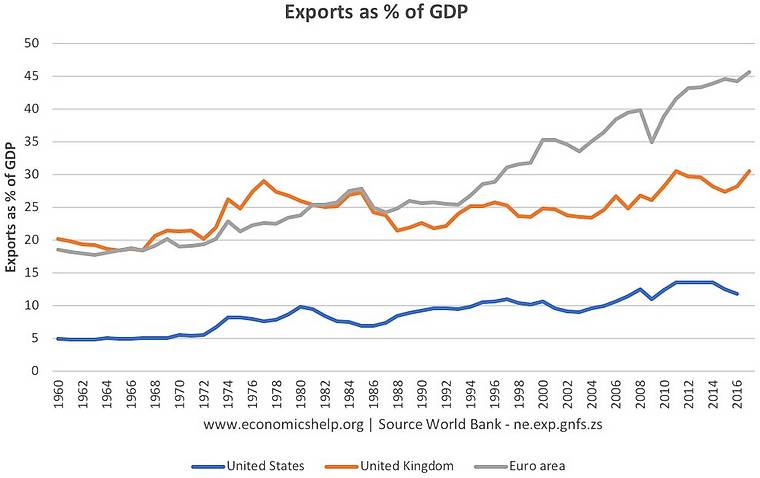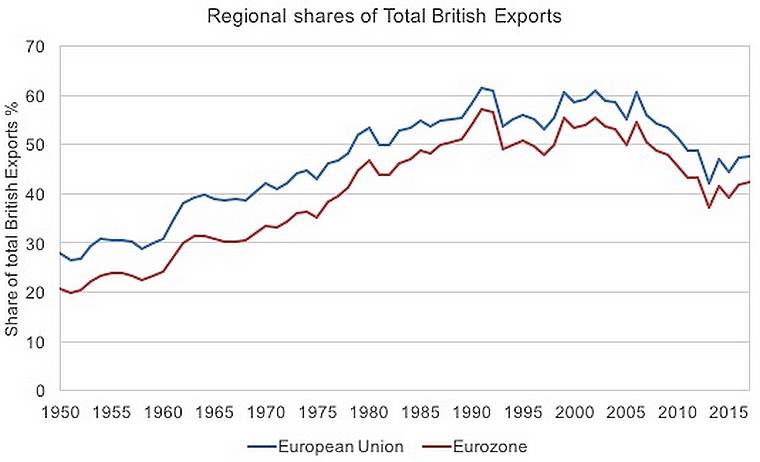
The type of trading nation the UK is influences the future and differs from common beliefs. In GDP terms, UK overseas trade is below average.

As the chart above shows, the US leads on low export levels, due to size which brings much internal trade and a solid consumer market. The EU quadruples their export to GDP ratio and countries like Thailand, or Vietnam would be even higher.
The UK is somewhere in between the US and EU and the EU makes up less than half of our exports, around 9% of GDP. We did not see the single market benefit levels many European countries have experienced since the 1990s.
There is no wish to lessen the importance of such a percentage. This is the difference between survival and prosperity but finding alternatives is possible, when our trade with the EU has been reducing for some time.
Recent Trading History

By some margin, the EU is our largest trading partner, yet exports to them have been decreasing for two decades. A peak of around 60% falling to 45%.
In GDP terms however, our reliance is greater than individual EU countries, including France and Germany. The fall has also steadied in recent years, led by services, which provide a trade surplus rather than the overall deficit.
Our profile is different, with a high level of services making up over 40% of sales to the EU. Neither should we assume this ability will fade away, when expertise in financial and technical support is less sensitive to trade terms.
Much will depend on sentiment, an aspect in the hands of our negotiators alongside a detailed agreement. The damage which can come from a company, or country being seen as less desirable to trade with is immeasurable.
An Uneven Effect
At corporate level, there will be sufferers but most can find ways to move forward. The same does not apply to small businesses which are EU dependent, or the myriad of sole traders who make there living in Europe.
Wales proportionately have the highest percentage of exports to the EU, followed by Northern Ireland, then the North East of England. Northern Ireland and the East of England bring in the highest proportion of goods from the EU.
Whilst the picture is not as clear cut as often raised differences across the UK may suggest, they are regions which will find replacement business harder. Items they import are also more likely to be part of a business chain, with greater ongoing benefit.
A reduction in the number of skilled and general workers coming from the EU will also impinge on economies in some places more than others. Solutions are likely to be more or less available, depending on local skills and employment levels.
Additional Factors
Whilst export figures tell a story, the base of our economic relationship with the EU runs deeper. We have been a valuable gateway to Europe for many non EU businesses, who saw linguistic, social, or practical advantages.
That link will be broken, as will the UK being a key destination for skilled and manual EU workers. A trend which brought overall economic benefit and is now in reverse, for reasons beyond the coronavirus pandemic.
Tariffs and additional admin will arrive, which have costs, as do legal differences and delays. Seeing issues is all too easy, yet advantages remain.
The UK’s educational and skill levels could always improve but are good, corruption is low, our currency stable, our products and services valued. As a trading partner, we are still seen by many as a rational choice.
A principle which will apply in many European countries, trade with the EU will reduce but by no means go away. Alternatives such as ATA carnets for Europe will become the new way and the more we adapt to change, the more we will succeed.

